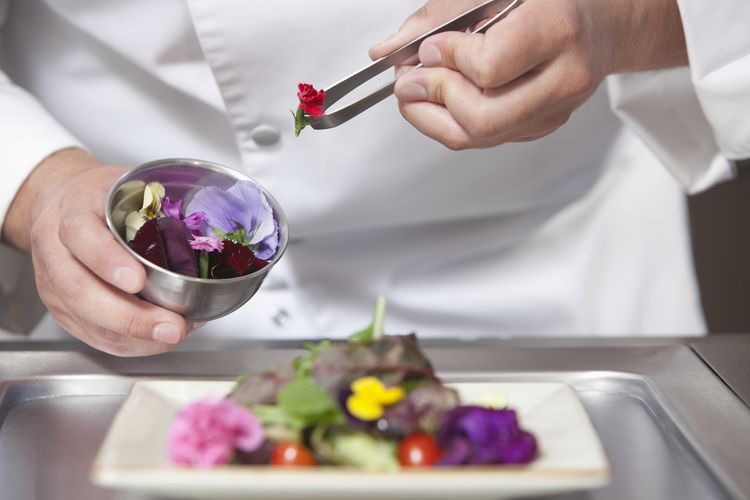In the world of gastronomy, the marriage of beauty and taste finds its most exquisite expression in the realm of edible flowers. From delicate petals adorning salads to vibrant blooms infused into desserts, the culinary world has embraced the aesthetic allure of flowers, turning them into captivating ingredients that elevate the dining experience. Let’s embark on a journey through the enchanting landscape of edible flowers and explore how these botanical wonders have become a source of inspiration Culinary Artistry for chefs and home cooks alike.

Top Burger Restaurants to Try in the USA
The Art and Tradition of Edible Flowers
A. Historical Significance
The use of flowers in culinary pursuits is not a modern phenomenon; it has deep historical roots. Ancient civilizations, including the Greeks and Romans, incorporated flowers into their feasts for both decorative and gastronomic purposes. In medieval times, flowers were a common ingredient in elaborate dishes prepared for royalty and nobility.
B. Cultural Symbolism
Beyond their culinary applications, flowers have held cultural significance throughout history. In various cultures, certain flowers carry symbolic meanings, often associated with love, celebration, or spirituality. Incorporating these flowers into dishes adds layers of meaning and cultural resonance.
Blossoming Flavors: A Palette of Taste
A. Floral Notes in Cuisine
Edible flowers bring a spectrum of flavors to the table, ranging from subtly sweet and aromatic to mildly peppery or tangy. Each flower variety contributes a unique essence, allowing chefs to play with a palette of tastes that add depth and complexity to their creations.
B. Common Edible Flowers
- Roses: Fragrant and delicate, roses impart a sweet floral taste. They are often crystallized or used to make rose water for desserts.
- Lavender: Known for its calming aroma, lavender adds a subtle floral flavor to both sweet and savory dishes. It’s a popular choice in baking and infusions.
- Violets: With a slightly sweet flavor, violets are often used in salads, desserts, or as decorative elements on cakes.
- Nasturtiums: Vibrant and peppery, nasturtiums bring a hint of spice to salads and can be stuffed or pickled for unique culinary creations.
- Hibiscus: Deep red hibiscus flowers lend a tart flavor, making them suitable for teas, syrups, or garnishes for desserts.
the Culinary Treasures of the Netherlands
Culinary Works of Art: Edible Flower Creations
A. Salad Elegance
Edible flowers are a natural fit for salads, transforming a simple dish into a work of art. Their vibrant colors and delicate flavors complement greens, creating a visually stunning and palate-pleasing ensemble. Arugula with pansies, violets, and nasturtiums, drizzled with a light citrus vinaigrette, is a feast for both the eyes and the taste buds.
B. Floral Desserts
Dessert connoisseurs have long celebrated the use of edible flowers to add a touch of elegance to sweet creations. Lavender-infused crème brûlée, rose petal macarons, or hibiscus sorbet showcase the versatility of flowers in the realm of desserts.
C. Floral Beverages
Beverages, too, have embraced the floral trend. Hibiscus iced tea, lavender lemonade, or rose-infused cocktails bring a refreshing and aromatic dimension to the world of drinks. The visual appeal of petals floating in a glass adds an extra layer of sophistication.
Culinary Caution: Selection and Safety
A. Safe-to-Eat Varieties
While many flowers are edible, it’s crucial to exercise caution and ensure that the chosen varieties are safe for consumption. Flowers from florists or garden centers may be treated with pesticides or other chemicals, making them unsuitable for culinary use. It’s advisable to source edible flowers from reputable suppliers or grow them organically.
B. Allergies and Sensitivities
Individuals with allergies or sensitivities to certain plants should approach the consumption of edible flowers with caution. It’s essential to be aware of any potential allergic reactions and introduce flowers into the diet gradually.
Growing Your Edible Flower Garden: A Botanical Adventure
A. Cultivating Edible Flowers
For those who wish to embark on a culinary botanical adventure, cultivating an edible flower garden is a rewarding endeavor. Flowers like calendula, borage, and chamomile are not only delightful additions to dishes but also easy to grow in a garden or even on a windowsill.
B. Organic Practices
To ensure the safety of edible flowers, adopting organic gardening practices is advisable. Avoiding chemical pesticides and fertilizers guarantees that the blooms are free from harmful substances, making them safe for consumption.
Conclusion: Blooms on the Plate, Art on the Palate
Edible flowers have transcended their ornamental role to become stars on the Culinary Artistry stage, contributing not only aesthetic appeal but also a bouquet of nuanced flavors. From ancient civilizations to modern kitchens, the tradition of incorporating flowers into cuisine continues to blossom. As chefs and home cooks alike experiment with floral creations, edible flowers serve as a reminder that the culinary arts are not only about taste but also about evoking emotions, telling stories, and celebrating the sheer beauty of nature on the plate. So, the next time you savor a dish adorn with petals, remember that it’s not just a meal; it’s a masterpiece craft from the vibrant hues and delicate flavors of edible blooms.